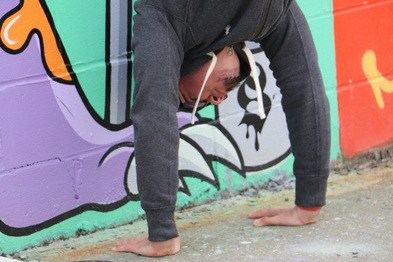 We're talking hands today and the importance of our palm, fingers and wrist in many asanas (postures). Very similar to our feet, both of our hands provide the stability needed for many of our poses. But unlike our feet, the muscles and bones that comprise both of our hands are not necessarily built for the same rigors of weight bearing, as we do on our footsies. Without getting too technical; the bones that exist in our feet are thicker, stronger and don't have the similar dynamic range of movements as those in our hands. They can withstand impact a lot more and sustain our body for most of the day during ambulation. We are used to writing, typing and being crafty with our hands, actions that do need a specific skill-set and different levels of dexterity, but how often are we really balancing on our hands and trying to weight bear, unless we're in a yoga class practicing arm-balances? Which is important to recognize how we can use our hands during these poses and come into an understanding of how to practice safely and confidently without worries of injuring our phalanges and wrist. Awareness about hand-placement on our mats should begin in downward facing dog (adho mukha svanasana). Are we bearing too much at the heel section of our hands? Maybe use a wedge or place a towel at the heel to help increase the range and lessen the severity of the angle. Are we leaning towards the thumb or pinky side more? Spreading your fingers apart, palms flat onto the mat and pressing evenly from the thumb all the way across the pinky side of your hand will take the weight off your wrist and transfer it up your arms and into your upper back where you have muscles better equipped to handle the load. Not having a steady flat surface with your upper extremities in down-dog could lead to tightness in the neck-area, a site of tension for many of us. Placing your hands wider than shoulder width distance apart, closer to the edge of your mat, could also alleviate the uneven-bearing on your hands while providing more area up the arm and into the shoulder for lessened tightness and more space to find stability into your hands. Beginning in table-top, shoulders above the wrist and hips over knees is a good initial position to find all your starting points mentioned above before tucking your toes under and lifting your hips into down-dog. In other poses, such hand-stand, how we use our hands, fingers and their engagement are imperative in building a steady foundation. You want the top part of your palms and your first set of knuckles to engage, which will help you activate the muscles of your forearm and upper arm. Your finger pads planted onto the mat will illicit a "tenting" action on the middle joints of your fingers. Good… because that will mean that your hands will work, instead of just collapsing onto your wrist when you go upside-down onto your handstand. Those finger-pads pressing down into the mat will help get those muscles in your hands that are used to mobility, get stronger for stability. This is a good starting for alleviating pressure from the wrist and finding awareness in our fingers during arm balances. Maybe try some of the tips mentioned and we'll continue to explore arm balances such as crow (bakasana), and maybe figure out together what things have served your body, or haven't. Any questions, comments, suggestions, complaints or observations are welcomed. I'll continue with a series of posts to follow-up and to expand on some of the things I've mentioned today based on your feedback and my own exploration. No one is wise by birth, for wisdom results from one own’s efforts.
1 Comment
|
AuthorVicyasa™, your full-time dopamine dealer ... don't allow my confidence to offend your insecurity. Archives
July 2024
Categories
All
|
 RSS Feed
RSS Feed